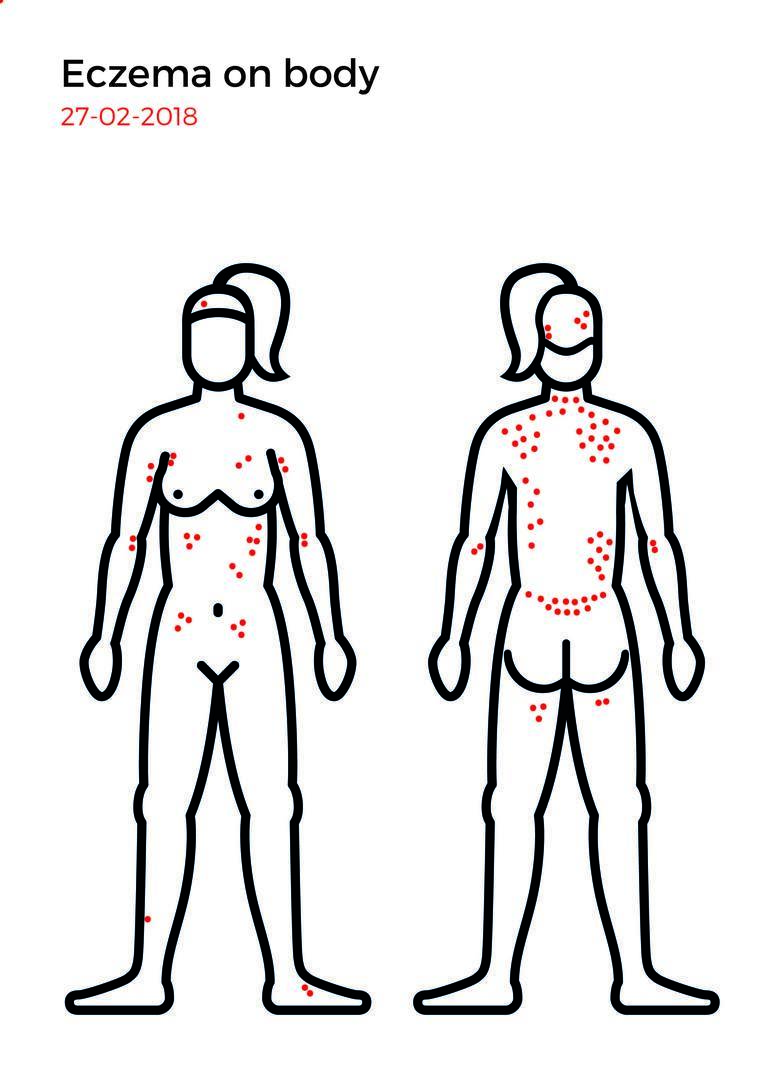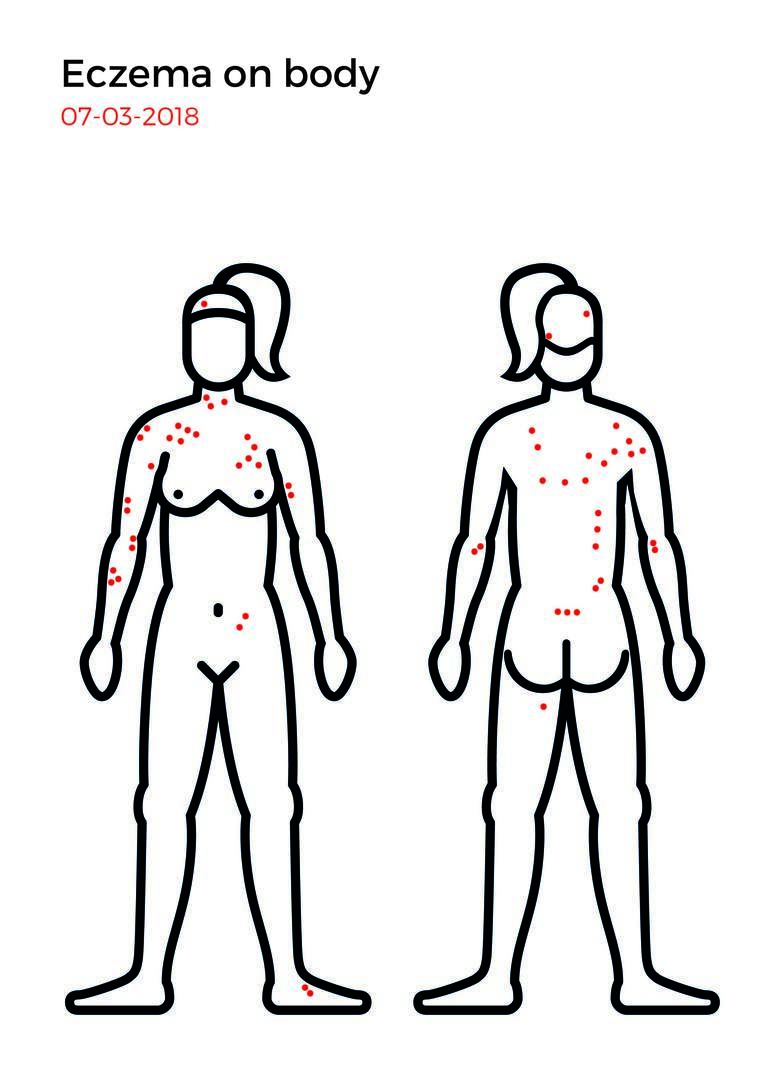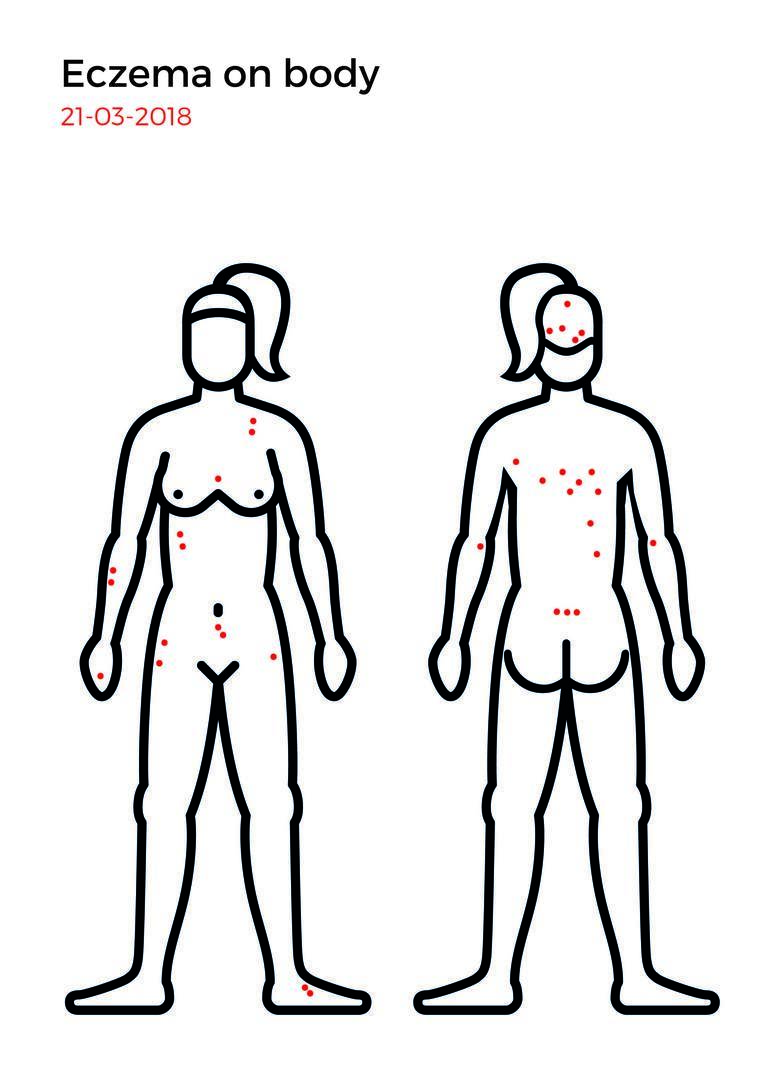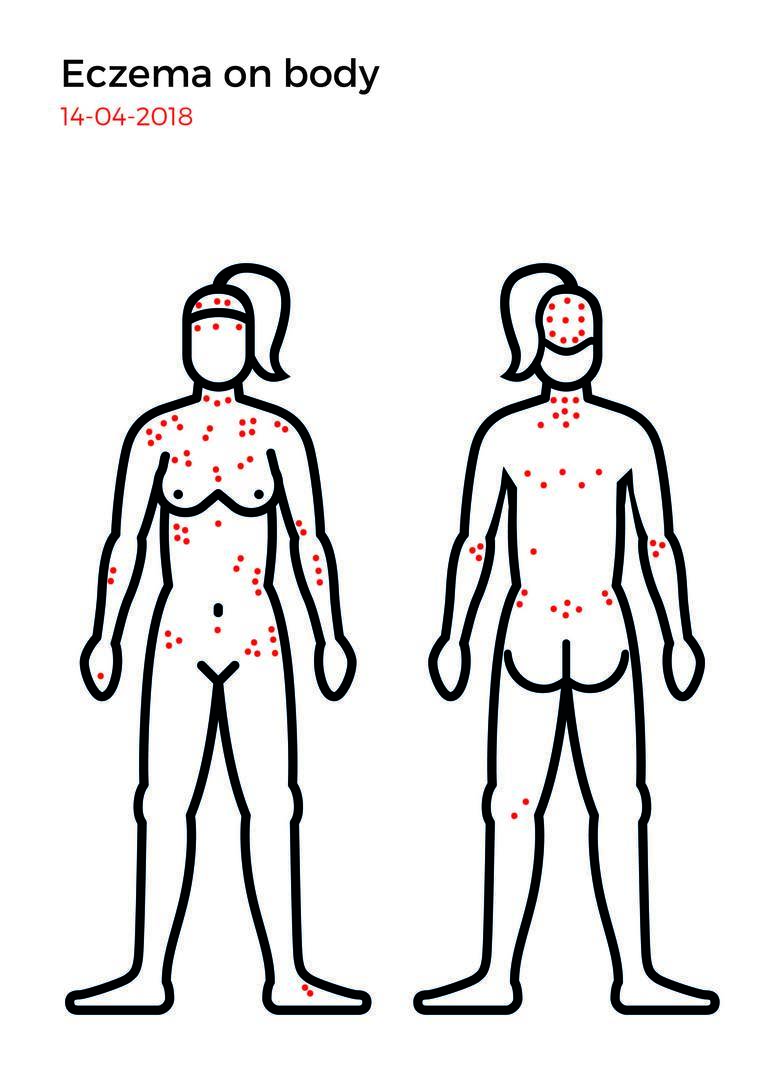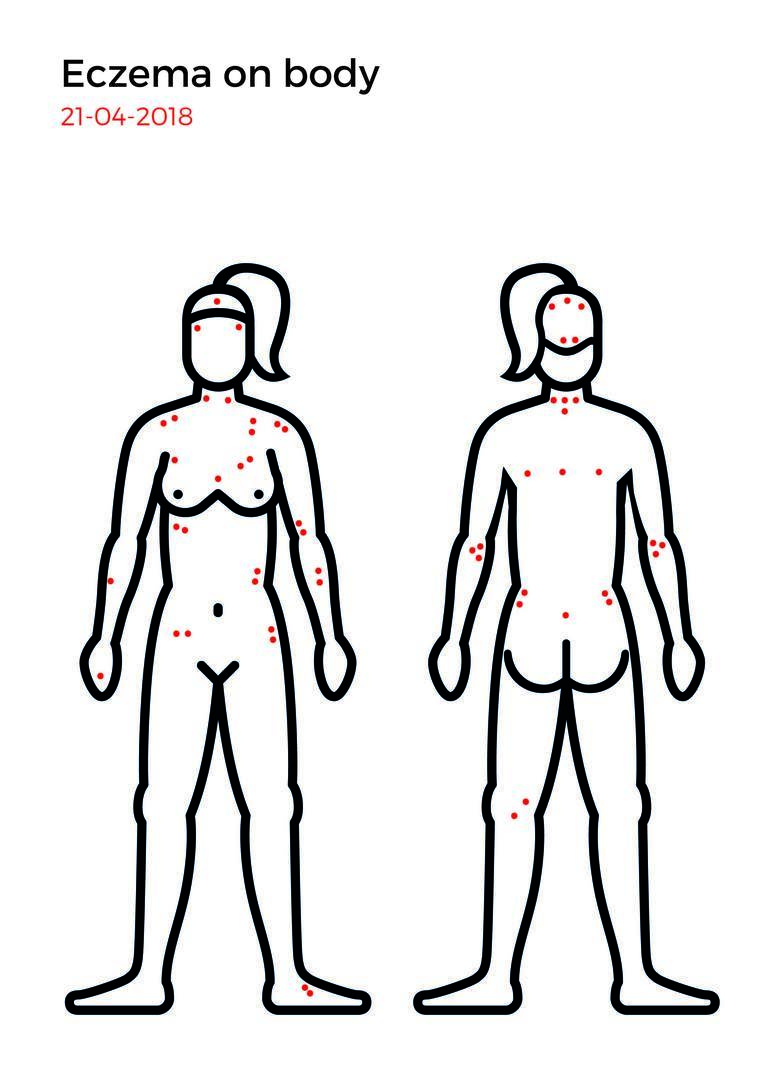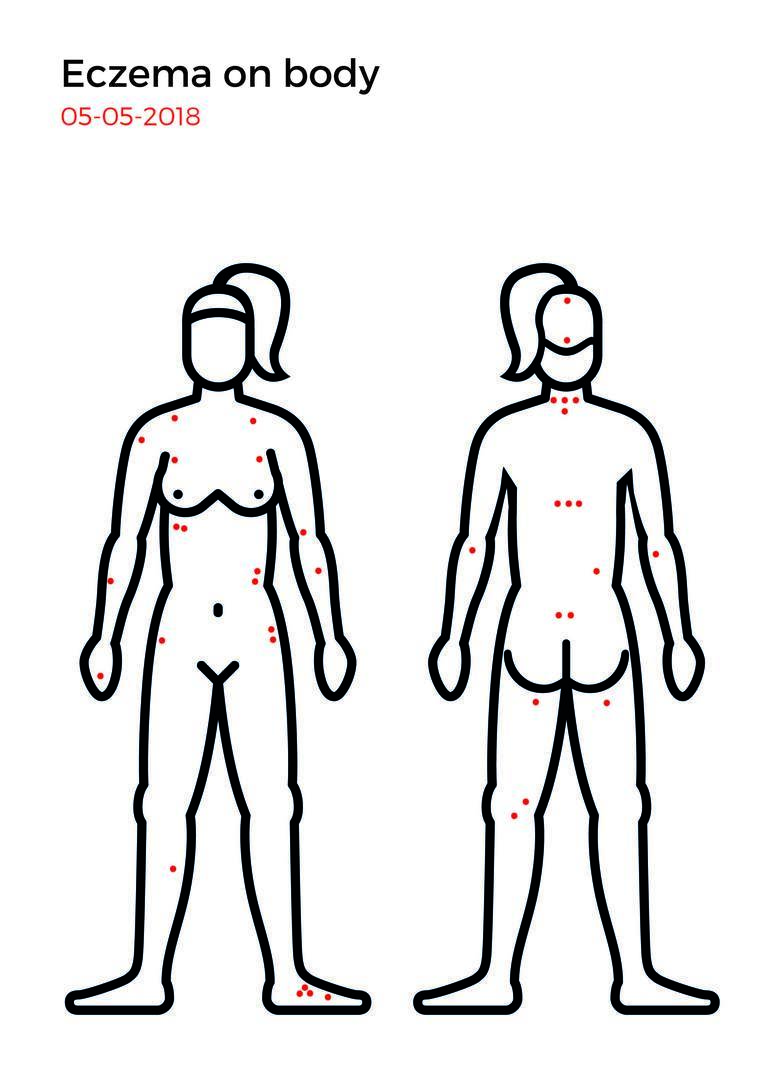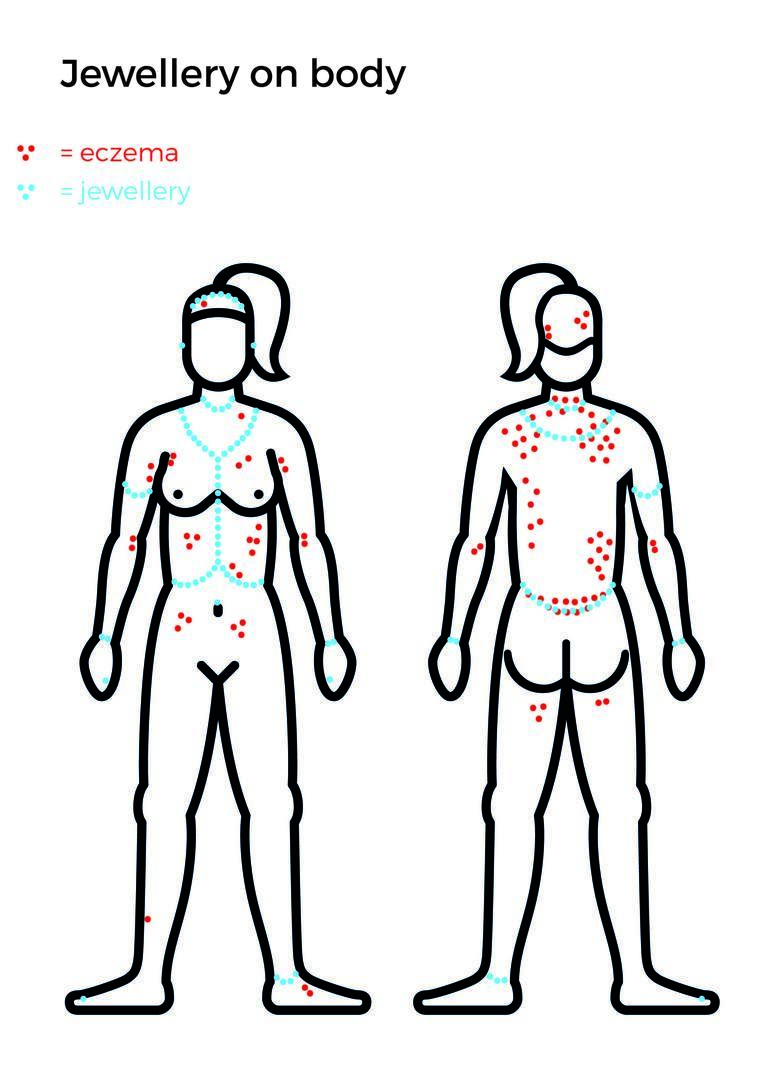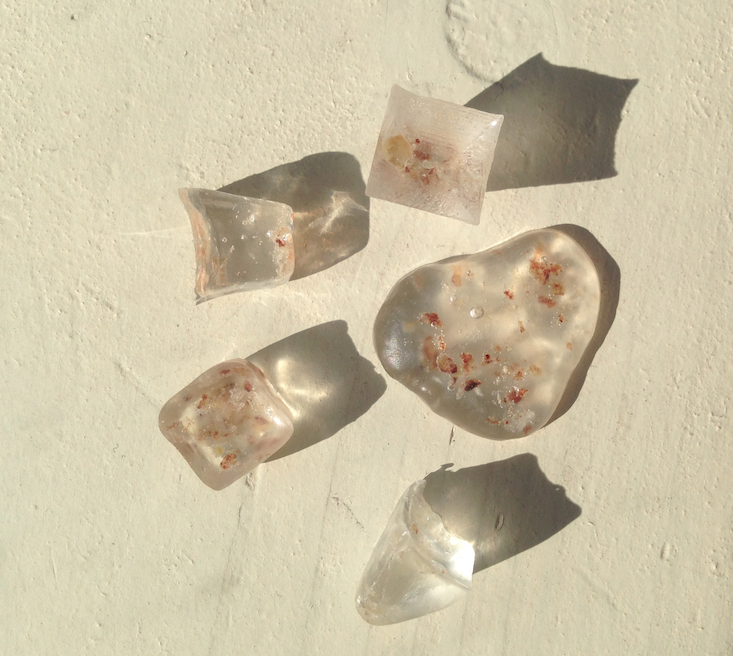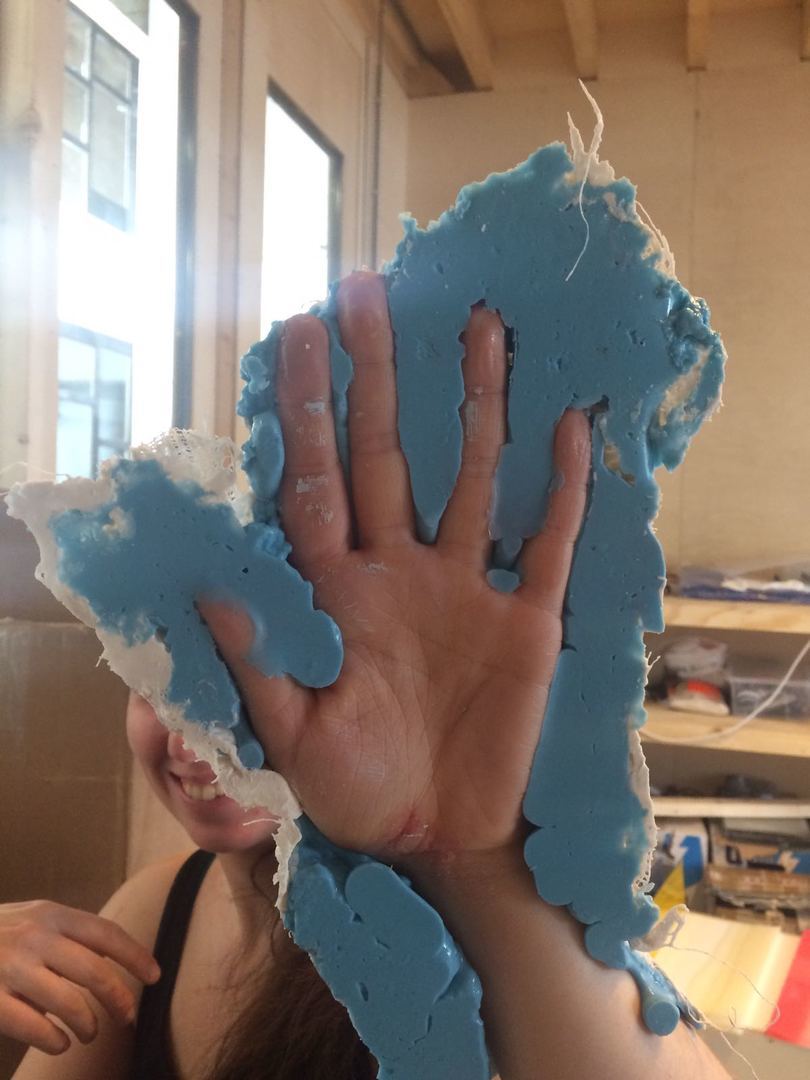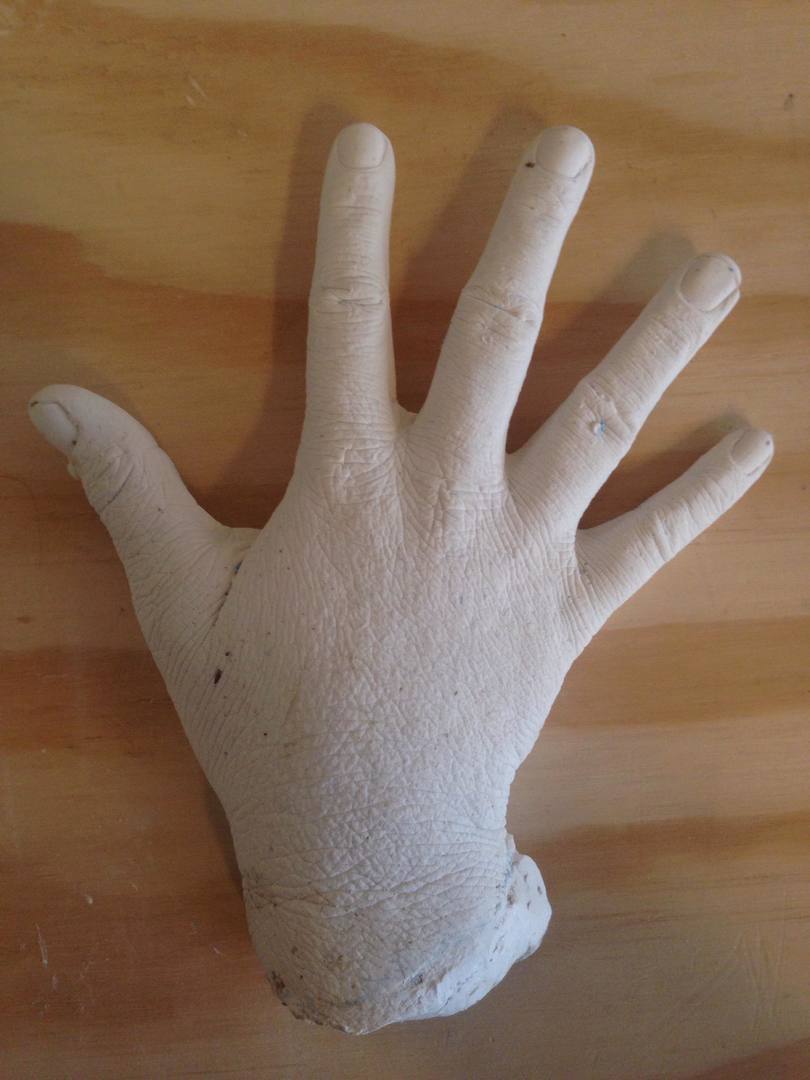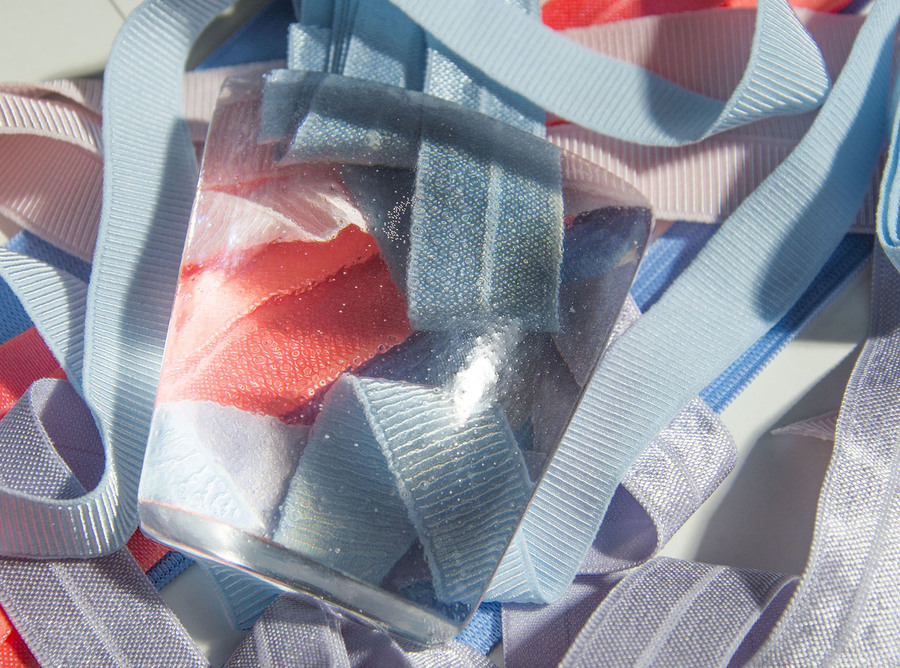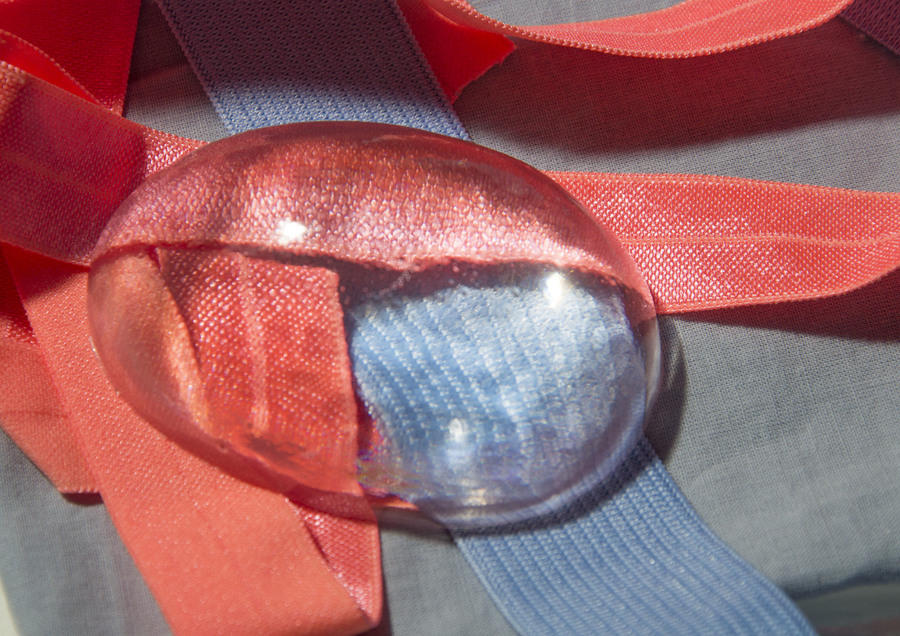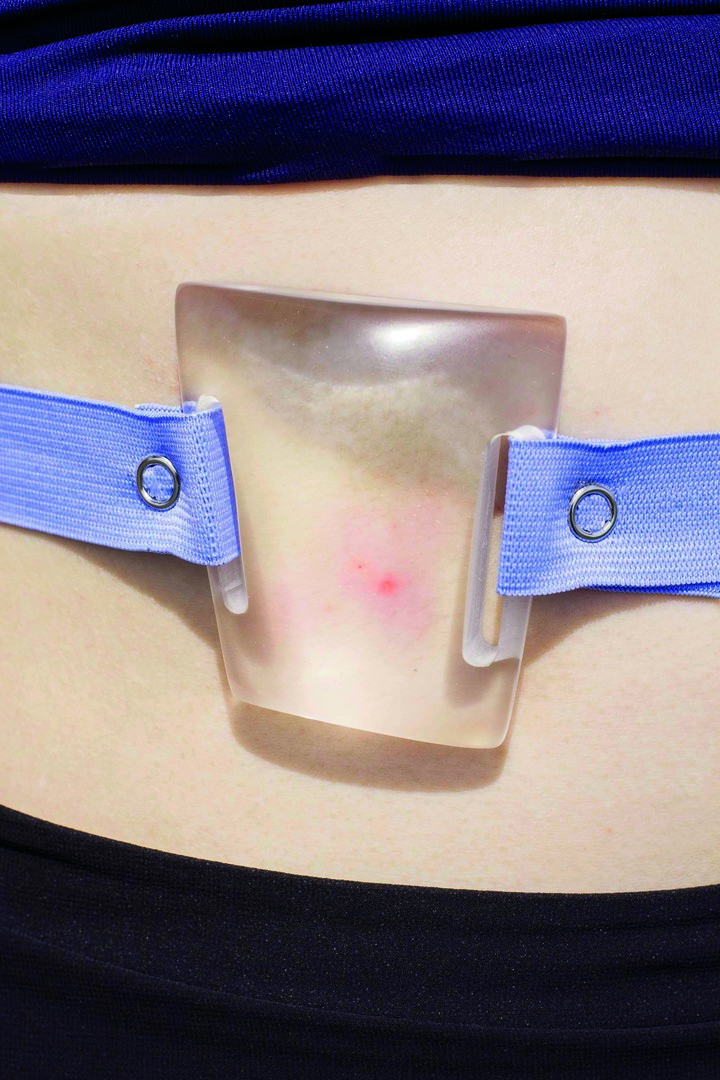Skin gems
Research question:
How can I design something that will help people with skin problems get over their shame?
Sub questions:
How can you overcome your own shame?
How do people with eczema deal with beauty?
How can I break the norm of eczema?
What is the hidden beauty of eczema?
Introduction
Eczema is a chronic skin disorder that affected around 245 million people globally in 2015 [1]. Eczema is mostly dry, red and itchy skin. Eczema sufferers have the habit to scratch and create painful, oozing wounds. I myself have been dealing with atopic eczema since I was an infant. After many years I am familiar with the treatments and side effects that come with eczema, such as thinning of the skin, loss of pigment and being more susceptible to infections.
Factors for eczema are: dry skin, irritants such as fragrance and cigarette smoke. Stress is also a major factor when it comes to eczema. Eczema caused by stress can cause huge mental health problems. People’s confidence will disappear and social activities will become more difficult to face.
Stress is also the biggest factor in my own eczema. But after years of struggling with my skin disorder, I decided to stop tormenting myself and accept my condition. I started wearing clothes that showed my skin in the summer and generally payed less attention to my skin, because I realized that this is a lifelong disease. This helped me to cut a lot of the stress out of my routine. Wearing clothes that I liked gave me more confidence too. I believe that because I was experiencing less stress through accepting my eczema, my eczema got less severe.
Throughout this document I will be trying to research this statement via various sources, experiments and eventually my final project. I will be focussing on how eczema affects sufferers mentally. Thus I will also be addressing the topics of shame, stress, self acceptance and the importance of dealing with these factors in the mental and physical healing process.
[1]. “Dermatitis.” Wikipedia, Wikimedia Foundation, 20 May 2018, en.wikipedia.org/wiki/Dermatitis. Last consulted, 25 April 2018
What is eczema?
Eczema or Dermatitis, is a skin condition where the skin is dry, flaky and itchy. Eczema can also be more severe, which means weeping, crusting and bleeding wounds. By scratching the skin frequently, wounds will form. Via these open wounds the skin is more prone to infections. People of all ages can develop or experience eczema, but it’s often seen in children. Children can “grow out” of their eczema, but it can always come back in a later period of their life. Eczema can be very different for many people and there are various forms of eczema.[2]
[2]. “National Eczema Society.” What is eczema?: National Eczema Society, www.eczema.org/what-is-eczema. Last consulted 11 May 2018
Body alarm
It’s not a nice way to let you know, but your eczema is literally telling your body that you’re too stressed or that there is something wrong inside your body. It’s a physical alarm bell. It is then your turn to listen to it and take care of it. Of course eczema can’t always be cured, but you will at least know that you have to take action to decrease it. If your eczema flares up because you’ve been neglecting your treatment, start it again. If it flares up because of stress, take a day off and relax or confront the source of the stress and talk about it.[3]
Community Eczema has a large impact on someone’s life. But there are many people in the same situation. Eczema can bring people closer together, for example: support groups and online support such as Psoriasishuid, Huidfonds and VMCE. Or simply someone in your environment with the same condition. [4]
[3]. CHOY, Lisa. “My Skin Talks To Me / My Story Living With Eczema / Advice on Eczema.” National Eczema Association, 23 Jan. 2018, nationaleczema.org/my-skin-talks-to-me/. Last consulted 30 May 2018 [4]. “VMCE Discussie Forum - Forumindex.” VMCE Discussie Forum - Forumindex, forum.vmce.nl/. Last consulted 03 June 2018
Research conclusion
Research has shown me that acceptance plays a very important role when it comes to healing mentally and physically from eczema. This can be done via talking about your conditions with a professional, friends or family. ‘Practicing’ your story will make it easier to tell it to strangers when they ask you questions about your skin. Another way is to stop covering up the eczema with clothing or make-up. Letting your skin breathe will irritate it less and showing your skin will show others that you’re not hiding your flaws, they can ask you questions and you can learn better to live with it than to hide it and gain more confidence.
The research that I have done has shown me that, in order to make something that will help eczema sufferers deal with their shame, the project will have to: get people to talk about their condition, make a step to acceptance and expose themselves to the outside world.
Jewellery for eczema
I had to decide what I really wanted to achieve as a designer and eczema patient. I strongly believe in the statement that accepting eczema and not hiding it, will cut out a lot of stress, and thus decrease the eczema. The main topic in this statement, next to eczema, is acceptance, shame and beauty. So I had to focus on which objects can bring these elements together. I came to the idea of creating jewellery for eczema.
Eczema and jewellery both are located on the skin and I realized that the location of jewellery is similar to the location of eczema such as, wrists, hands, fingers, arms, torso and neck. My goal is for people to show their eczema, so I wanted to make jewellery pieces that would accentuate the spots.
Clothing-wise there are only medical clothes available, I thought this to be a gap in the eczema market. An item that doesn’t have a medical feeling to it, that can be worn during the day as a normal item, that is appealing to look at and that can give you confidence. Because after all, in many cases, eczema is for life. And most products available are to relieve the sufferer from as many symptoms as possible. But there is nothing to just accept it, and live with it, day to day, as if it’s a ‘normal’ thing. Because it should be seen as something normal. Via this jewellery the eczema would be covered, but because you can combine it with crème or ointments it becomes a treatment similar to the saran wrap method and thus moisturize the skin for a longer period of time. I saw many possibilities in this project and chose to further develop it.
In order to make jewellery I had to research what different types are out there. I also researched on which locations jewellery is worn and how it relates to eczema.
Existing jewellery types - Necklace, choker, locket, statement necklace, medallion - Bracelet, bangle, armlet, anklet - Ring, wedding ring, engagement ring, signet ring, toe ring - Earring, piercing - Brooch, cufflinks - Hairpin, diadem, tiara, crown [5] [6]
[5]. “Welke Soorten Juwelen Bestaan Er Allemaal ?” Juwelen En Sieraden Informatie Blog, 16 May 2009, www.juwelen-sieraden-info.be/soorten-juwelen/. Last consulted 23 April 2018 [6]. “Types of Jewellery” American English Definition and Synonyms / Macmillan Dictionary, www.macmillandictionary.com/thesaurus-category/british/types-of-jewellery. Last consulted 30 May 2018
On which body parts are jewellery worn?
The usual locations on the body where jewellery is worn are on the neck, ears, arms & wrists, fingers & hands, ankles & toes, torso and hair. Piercings can be worn anywhere but often exist out of: nose, ears, lips, tongue, bellybutton, eyebrows, chest, nipples, genitalia.
How does jewellery relate to eczema?
Jewellery is mostly located on the skin. So is eczema. The locations of eczema and jewellery can be very similar such as the neck, wrists, hands, fingers, torso and feet. Eczema can be developed from a contact allergy to nickel.
In cheaper jewellery, nickel is often used in the base metal which is plated with gold or silver afterwards. People who think that they’re have an allergy to gold or silver, actually have an allergy to nickel. Nickel can occur as a trace element in gold or silver or has been used in the manufacturing process of gold jewelry to whiten and/or strengthen the piece. For people with contact eczema, rashes will develop in places where nickel is touching the skin. Common locations of jewellery allergy on the body are: the earlobes, the fingers, and around the neck, the rash is intensely itchy and may become red and blistered or dry, thickened and pigmented. [7]
As a reaction to this information I looked for ways how jewellery could be useful for eczema. The material is very important. Even if it’s silver or gold, it can still cause irritation. A difference between eczema and jewellery is that eczema can also occur on a body part where you don’t wear jewellery such as the legs. That’s why I find it important that my jewellery collection will be adjustable and can move around the body. It also has to be made out of a material that is easy to clean and doesn’t irritate the skin.
[7]. NGAN, Vanessa. “Jewelry Allergy.” What Is a Dermatologist? What Is Dermatology? / DermNet New Zealand, 2012, www.dermnetnz.org/topics/jewelry-allergy/. Last consulted 30 May 2018
Project description
Skin gems
Skin gems is a jewellery collection made for people with any type of eczema. The collection exists out of pieces that are specifically made for certain body parts and general pieces that can be placed on any part of the body and be moved around.
The jewellery is meant to be placed on top of the damaged skin. The main part of the jewellery is an epoxy resin ‘stone’ that has a magnifying effect. Via magnifying your eczema, you are no longer hiding your condition from the world, you’re accepting it. By accepting your eczema, you will have less stress, and less stress means less eczema. You can keep treating your eczema by applying your ointment underneath the jewellery. You’re now using your eczema as a decoration while treating it physically and psychologically. By wearing these pieces you show the world that you question what beauty looks like, and that you are not afraid to show yourself.
Relevance Worldwide there were 245 million people suffering from eczema in 2015. The products available for eczema patients usually contains out of cotton nightwear and cotton gloves. These products are meant to wear at night to stop you from scratching, or to wear under your normal clothing (wet wrap). The items are unappealing, have a medical feeling to them and are meant for a treatment that doesn’t work for everybody.
With my jewellery collection I can offer eczema patients something new and something they could want to wear. Jewellery specially made for them. The jewellery covers the eczema, and ointment can be applied under the epoxy stone which will help the ointment to soak into the skin. This method is similar to the treatment done with saran wrap.
Target group The jewellery is aimed at women and men with eczema, who like to wear jewellery.
Research by making
Inspiration To see what’s already out there and to get some inspiration, I kept up a Pinterest blog. I found many inspiring images from other designers that also played with the boundary, function and shape of jewellery. I would analyse how the jewellery is presented, is there a background, is it on a model, which colours are used? I found patterns and textures that could be useful for my project. With everything I found interesting I would reflect back how I could make it work for my own project and if it’s necessary.
Skin flakes I tested how eczema could relate to jewellery. When you scratch, you produce skin flakes. When I lose some flakes, I check what they look like. Some are just white, dried skin. Others are a brown crust from dried blood, another type were bright yellow, red or orange. They looked like little crystals. This made me link skin flakes to small gemstones. I started to gather as much flakes as I could and categorized them by the colours ‘white’ ‘brown’ and ‘yellow’. I wanted to cast them in transparent epoxy because it has a magnifying effect, and this seemed interesting for the small skin flakes. I made models out of clay and wood and vacume formed them in the ceramic station. I ended up with a plastic casting mold for the epoxy.
Result After the casting, I took out the small skin flake stones. I immediately noticed that it was very hard to tell that they were skin flakes. Because the flakes are so difficult to gather, a large quantity would be difficult to manufacture. I also had my mind set on making the jewellery for other people with eczema, and asking them to collect their skin flakes and give them to me, seemed a little farfetched. I also noticed that gathering the flakes made me scratch more because I wanted the flakes, and I didn’t want to be responsible for other people’s eczema. So I decided to research further.
Prototypes
The epoxy material and the magnifying effect was very exciting. Instead of magnifying skin flakes I decided to simply magnify the eczema that is already present on the skin. This is meant as a statement for the wearer that he/she is not ashamed of his/her eczema and is even magnifying it, so the opposite of hiding. This action can bring other actions in motion such as gaining confidence, learning to accept your condition, letting others witness your condition and gain more knowledge about it.
Moldable models My first idea was for the jewellery to follow the curving of the body. So I made alginate molds of myself and other people. In these molds I could then cast plaster to get a perfect print of the body parts. I did plaster castings of every body part that I wanted to design for. On this casting I could then make clay shapes (with 2 hands instead of 1). To determine the shape, clay was a useful material to work with. I could quickly make some shapes and see how it looked on the body. I would let the shapes dry and sand them as smooth as possible afterwards. After the sanding I would vacuum form the shapes and casted the resin.
Epoxy
I wanted a magnifying effect from the epoxy, but my first tests had a hollow bottom that would follow the curve of the body. In order to get this magnifying effect, the bottom has to be flat and the top round. It was also important to cast in an open mold instead of a closed silicone mold because the air inside the resin has to escape. Else bubbles will get stuck in the resin.
Campaign
Instagram In order to reach the audience, I’ve started the campaign with an Instagram page. I posted pictures of good tests in order to show people what I’m working on. Via hashtags and a short biography text I can make clear what the project is about. When photographing for my account I use the same blue background in order to create a look and feel for the page. I will also contact popular bloggers that are posting about their eczema in the hope that they will do a post about my project. https://www.instagram.com/skin_gems/
Links
CONTRIBUTE
Feel free to contribute to Beyond Social.

